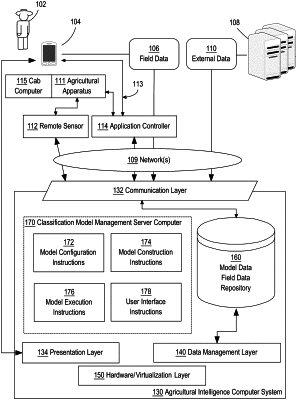| CPC G01N 33/0098 (2013.01) [G06F 18/23 (2023.01); G06F 18/2431 (2023.01); G06N 3/08 (2013.01); G06V 10/764 (2022.01); G06V 10/82 (2022.01); G06V 20/188 (2022.01); G06V 20/38 (2022.01)] | 16 Claims |

|
1. A system for configuring and utilizing deep learning for plant disease recognition, the system comprising:
a memory; and
a processor coupled to the memory and configured to perform:
receiving a set of photos of plants showing leaves with a plurality of marked regions having multiple aspect ratios, each marked region being associated with a label of a disease of a plurality of diseases and showing at least one lesion caused by the disease;
dividing, combining, or removing one or more of the plurality of marked regions to create a new set of marked regions in accordance with a restriction on a size of a marked region, on a size proportion of a cluster of lesions within a marked region to a leaf, or on a density of lesions within a marked region based on a predefined percentage;
normalizing one or more of the marked regions in the new set of marked regions based on a fixed distance between a camera and a plant and a fixed camera resolution;
determining, by the processor, a group of anchor boxes from the new set of marked regions for each of a series of convolutional layers of a single shot multibox detector (SSD), the SSD configured to receive an image and assign each of one or more areas of the image into at least one of a plurality of classes corresponding to the plurality of diseases, the group of anchor boxes having distinct aspect ratios and corresponding to various features of the plurality of classes;
mapping each of the plurality of marked regions to one of the groups of anchor boxes;
building the SSD from the group of anchor boxes, the set of photos having the plurality of marked regions, the associated plurality of labels, and the associated plurality of mappings;
receiving a new image from a client device; and
applying the SSD to the new image to identify symptoms of one or more diseases in one or more areas of the new image.
|